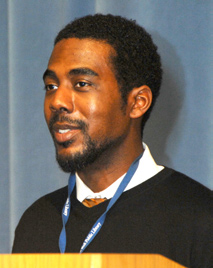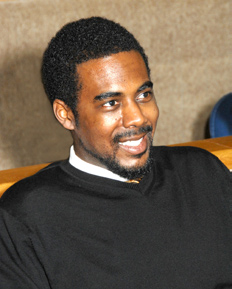 |
| Dr. Samuel Roberts |
In his Feb. 8 lecture, “New (Social) Histories for New (Social) Politics: Thinking About African-American Health History in Ways that Matter,” he discussed how at least as far back as the late 19th century, social uprisings have forced changes to the nation’s health status. “Even black physicians—so rarely prone to radicalism—created their own variety of protest politics,” he said, noting establishment
in 1895 of the National Medical Association. NMA was begun as the African-American equivalent of the American
Medical Association, which did not accept black members
at the time.
Roberts is an assistant professor of history at Columbia and of sociomedical sciences at Mailman School of Public Health. NLM’s History of Medicine Division sponsored the talk.
“Most public observances of Black History Month pay some sort of tribute to the Civil Rights Movement,” he said. “This year may be more appropriate than others. Aside from the fact that the next elected U.S. president could very well be an African-
American man or a European-American woman, there’s much about the 2008 campaign that looks like campaigns in 1964 or 1968 in that the major issues once again surround the war, the economy, poverty, citizenship rights and health care.”
Roberts said civil rights protests benefited more citizens than just African Americans. “The general understanding by the movement’s leaders and members is that it’s as much about class as it is about race,” he said. “Civil rights is an acknowledgment
of the socioeconomic impact of racism.”
Taking a brief tour of bygone eras, Roberts said noted African-
American scholar W.E.B. DuBois was one of the first to suggest and present evidence publicly that black inferiority in health and education status, for example, was due not to innate biological differences among the races, but to “socioeconomic
exclusion. However, it was not an idea whose time had come.”
 |
| Roberts, of Columbia University,
discussed the relevance of employing protest politics to combat today’s health disparities crisis. |
The Dubois-led Niagara Movement, which gave rise to the NAACP, mentioned health explicitly in its 1905 declaration: “We plead for health—for an opportunity to live in decent houses and localities, for a chance to rear our children in physical and moral cleanliness.”
Although the violent race riots of the early 20th century are not generally connected to direct improvements in African-
American health, they were part of the same political moment that brought about the spread of National Negro Health Week. The observation envisioned and organized by Booker T. Washington and others, but not held until shortly after Washington’s death in 1915, grew slowly but steadily.
By the 1930s, hundreds of thousands participated annually.
By the time Congress passed the 1946 Hill-Burton Act to address American workers’ health, Roberts said “pathologies of the ghetto”—diseases wrongly linked to race and color, and more accurately due to poverty—
were already part of the national conversation on U.S. health. That “health seemed purchasable was a widely held assumption.”
Over the years, outraged citizens banded together to protest in groups. The medical committee for human rights, the Student Health Organization and the Black Panthers were among the most well known.
“It’s difficult to assess how effective they were,” he said, “but certainly the political consciousness they raised was very important. We have thousands of community leaders who emerged from this period with a different consciousness about citizenship and health.”
Roberts suggested that today’s environmental justice
efforts are an extension of movement politics. In the 1970s, Warren County, N.C.— widely recognized
as the birthplace of the movement—dumped hazardous waste in a predominantly poor black neighborhood. Following well-publicized demonstrations
by thousands of citizens that included locally and nationally elected officials, North Carolina
agreed to clean up the site. The state spent more than 20 years restoring the land.
Today 9.2 million people are estimated to live within 3 kilometers of the nation’s 413 commercial hazardous
waste facilities; more than 5.1 million of them are people of color.
“Essentially the catalyzing moment is when various
communities look about themselves and see that they have had locally unwanted land uses forced upon them,” Roberts said. In what he described as a “devil’s bargain, many places will promise jobs and economic improvement in exchange for having a toxic facility located in a neighborhood.”
What is the connection between geographic social and health inequalities and such disorders as cardiac disease,
tuberculosis and HIV-AIDS? Some experts have mentioned the Chicago heat wave of 1995 and post-Katrina as environmental justice issues. “In an era when the policy of segregation has been definitively outlawed,” Roberts said, “what do we make of unequal environmentally induced health burdens?”
Studying environmental inequality history will help us think about all other sorts of history, he concluded. “If we can broadly think about environmental issues encompassing not just toxic dumps and local land uses, but also asthma, infant mortality, even the distribution
of fast-food restaurants, and tobacco and alcohol advertisements, [then] this offers us a way of thinking about social issues as a whole. Certainly if this harkens back to the old way of thinking, it might help us consider
what is real on the horizon in 10 or 20 years.” 